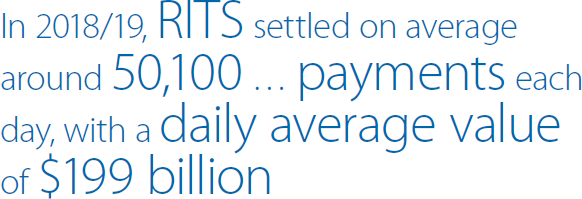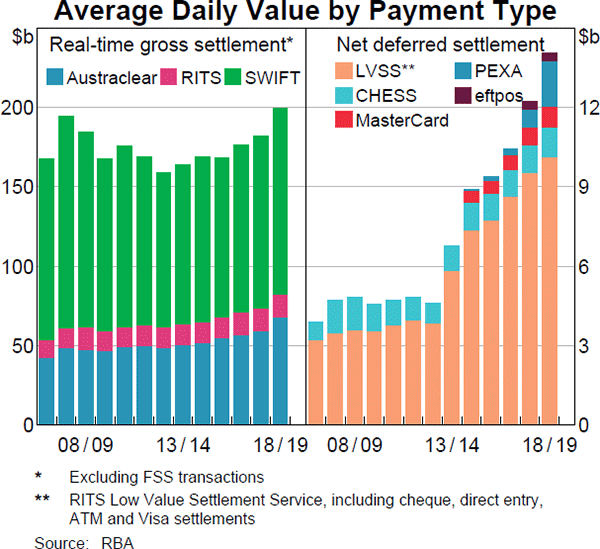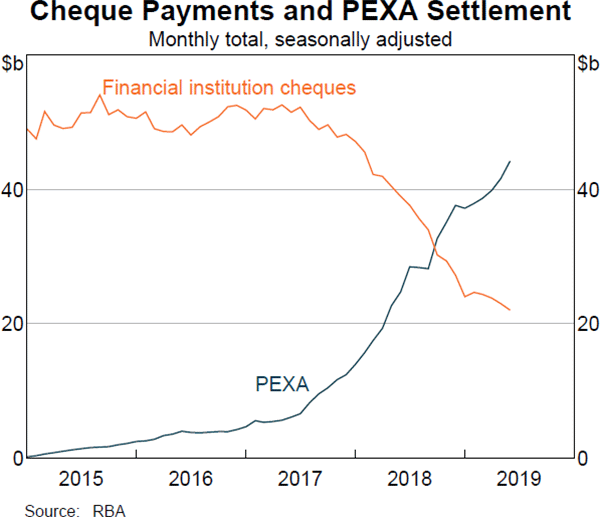Reserve Bank of Australia Annual Report – 2019 Banking and Payment Services
The Reserve Bank provides banking and payment services to meet the needs of the Australian Government and to support the efficient and stable functioning of the Australian financial system. During 2018/19, the Bank completed a number of multi-year projects to renovate and strengthen its banking and settlement capabilities. In addition to operating Australia's real-time gross settlement (RTGS) system, the Bank operates new national infrastructure to support the settlement of real-time payments by households and businesses on a 24/7 basis. The Bank also developed services that enable the Australian Government to access 24/7 payment capabilities. These services are consistent with the Bank's strategic goal of providing innovative, high-quality, banking and payment services to the Australian Government and its agencies and, in turn, the Australian public.
Banking
The Reserve Bank aims to deliver secure and efficient banking and payment arrangements to the Australian Government and its agencies. The Bank also provides banking and registry services to a number of overseas central banks and official institutions.
As part of the central banking services that the Reserve Bank provides to the Australian Government, the Bank manages the consolidation of all Australian government agency account balances. This service is provided irrespective of the financial institution that provides transactional banking services to each Australian government agency. Daily payment instructions from the Department of Finance (Finance) are processed to move funds from the government's accounts with the Reserve Bank to agency bank accounts to meet their payment obligations. Over the course of the year, the Reserve Bank has been working with Finance on its multi-stage plan to modernise the government's cash management, including using New Payments Platform (NPP) capability where possible.
While the Reserve Bank manages the consolidation of the government's accounts, the Australian Office of Financial Management has responsibility for ensuring there are sufficient cash balances to meet the government's day-to-day spending commitments and for investing excess funds in approved investments, including term deposits with the Reserve Bank. The Reserve Bank also provides a very limited short-term overdraft facility to cater for occasions when there is unexpected demand for government cash balances. This overdraft facility is used infrequently and was not drawn upon in the reporting period.
The Reserve Bank has a long history of supporting Australian government agencies through the provision of secure, reliable and cost-effective transactional banking services. While these services cover a broad range of payment and collection activities the bulk of the Australian Government's payments are made via the local low-value direct entry systems both domestically and overseas, and primarily relate to welfare or pension payments made on behalf of the Department of Human Services (DHS). In 2018/19, the Reserve Bank processed around 311 million domestic and 1.1 million international payments, totalling $545 billion and $13 billion respectively. The Australian Government also makes payments using a number of other payment systems, including the RTGS system, cheque, BPAY and prepaid cards. In line with broader industry trends, cheque payment volumes continued to decline, falling by a further 9.5 per cent over the course of 2018/19.
In addition, the Reserve Bank provides government agency customers such as the Australian Taxation Office (ATO) with access to a number of services through which they can collect monies owed from both domestic and international payers. These include direct entry, RTGS, BPAY, cheque, eftpos, cash, card-based services via the internet and phone, and the NPP. The Reserve Bank processed 39 million collections-related transactions for the Australian Government in 2018/19, amounting to $551 billion. Agencies continue actively to encourage customers to use lower-cost electronic payment options, with cheque and cash payments declining by 14 per cent to $4.1 billion and electronic payments representing 99 per cent of all collections-related transactions in 2018/19.
The nature of the transactional banking services offered by the Reserve Bank is evolving rapidly with changes in payments technology and business processes. As this is occurring, the Bank is supporting its government agency customers to embrace new technologies and processes to deliver convenient, reliable and cost effective payment options. An important milestone in this area was the implementation by DHS of a new NPP payment capability in late 2018. The implementation allowed real-time urgent, crisis and disaster relief payments to be made, notably during the Tasmanian bushfire and the Queensland floods. Since then, the number of outward NPP transactions processed by the Bank has averaged around 20,000 per month. NPP collections activity has also grown. The Bank processed around 155,000 NPP collections in 2018/19, totalling $1.1 billion, primarily on behalf of the ATO. The Bank expects that the NPP will gradually affect volumes for its more traditional payment and collection services in coming years, as agencies transition to offering more real-time payment options and other financial institutions expand their NPP services.
The provision of transactional banking services is consistent with the Reserve Bank's responsibilities under the Reserve Bank Act 1959, which requires the Bank to provide these services to the Australian Government if required. The Bank provides transactional banking services to over 90 Australian government agencies. A key difference between the Bank's central banking and transactional banking services is that the latter is offered in line with the Australian Government's competitive neutrality guidelines. To deliver such services, the Reserve Bank competes with commercial financial institutions, in most instances bidding for business via tenders conducted by the agencies themselves. The Bank must also cost and price the services separately from its other activities, including central banking services, and meet a prescribed minimum rate of return.


The Reserve Bank works closely with its transactional banking customers, the Australian Government and the payments industry to ensure that its customers and the public have access to the services that meet their banking needs. Bank staff also contribute to industry initiatives to ensure the interests of the government, as a significant user of payment services, are represented. For some services, the Bank combines its specialist knowledge of the government sector with specific services and products from commercial providers. Responding to the community's increased use of ‘wallets’ as a payment method, the Bank has been actively working to utilise this payment channel to expand the options available to government agencies for collecting online payments. The Bank has also implemented its Application Programming Interface (API) Gateway, which will facilitate instant, secure, and automated communications between the Bank and its agency customers. The first service via API was delivered for DHS in late 2018/19. The Bank is looking to leverage this capability further to support the expansion of the NPP and other services to benefit the Bank's agency customers. Further use of combined service arrangements with commercial providers will be explored as the government's banking needs evolve.
Registry services are also provided by the Reserve Bank to supranational organisations issuing Australian dollar-denominated securities. Eight organisations currently use these services, with this number having been relatively steady over recent years.
The Reserve Bank has undertaken a significant program of work to upgrade its banking systems since 2012. In 2018/19, the Bank successfully completed the upgrade of the account maintenance system and systems used to process government payments and collections to a more modern programming language and architecture. The Bank has also completed re-engineering a number of related business processes. The final implementation of this program of work was completed during the September quarter 2019.
Pro forma business accounts for transactional banking are provided as a separate chapter of this report. After-tax earnings from the Reserve Bank's transactional banking services were $6.3 million in 2018/19, $4.8 million higher than in the previous year.
Settlement Services
The Reserve Bank Information & Transfer System (RITS) is a critical piece of payments infrastructure that sits at the core of the Australian financial system, enabling the fast and reliable transfer and settlement of payment obligations between financial institutions. These institutions hold Exchange Settlement Accounts (ESAs) with the Reserve Bank, which are credited and debited by RITS to finalise settlement of payment obligations arising from transactions undertaken by their customers. Around 90 per cent of the value of payments exchanged between financial institutions in Australia is settled in RITS on an RTGS basis. These payments include large customer, corporate and institutional payments, wholesale debt and money market transactions, and the Australian dollar leg of foreign exchange transactions. In 2018/19, RITS settled on average around 50,100 of these payments each day, with a daily average value of $199 billion. Over the course of a year, this amounts to around 25 times the total value of economic output in Australia.
The Fast Settlement Service (FSS) is a RITS real-time settlement service that supports the operation of the NPP. Since launching in February 2018, NPP and the FSS have provided real-time payment services that allow retail consumers to make and receive payments immediately, 24 hours a day, using simple identifiers (PayIDs), such as email addresses, phone numbers or Australian Business Numbers (ABNs). At the end of June 2019, there were more than 3.1 million registered PayIDs, and more than 80 institutions were offering NPP payments to their customers. Uptake of the new services, however, has been constrained by delays at certain major commercial banks in rolling out NPP functionality to their customers. Some NPP participants have also had problems maintaining the operational stability of their new systems and the number of outages in 2018/19 was higher than other payment channels.
At the end of June 2019, the volume of transactions processed by the FSS reached around 428,000 per day, with an average daily value of $404 million. Most of these payments have migrated from the existing direct entry (‘pay anyone’) clearing stream, but some may also have moved from traditional payment methods such as cash and cheques. The average value of payments settled in the FSS was around $940 in June 2019, reflecting the predominantly retail nature of the payments currently being processed.

Despite growth in the use of the NPP, most retail payments are still settled on a deferred net basis in RITS. Around $10 billion of these payments are settled in the RITS Low Value Settlement Service (LVSS), which settles obligations arising from the clearing of cheques, some debit and credit cards, BPAY, ATMs and direct entry. For these transactions, RITS combines the bilateral clearing obligations submitted by members into a single settlement at predetermined times. Most direct entry transactions are settled in five intraday settlement runs, while other obligations are settled at 9.00 am the next business day. Growth in the value of net settlement through the LVSS has been strong over the past six years, owing to a combination of continuing growth in non-cash payments, some loss of netting efficiency because of the introduction of the intraday settlement runs in 2013, and shifting patterns of settlement processing by LVSS participants.



The remaining net deferred settlements, totalling around $3.9 billion, are externally administered batch arrangements. These include batches that settle obligations for Mastercard and eftpos transactions, stock market transactions processed by the ASX Clearing House Electronic Sub-register System (CHESS), and electronic property transactions processed by Property Exchange Australia Limited (PEXA). Each batch administrator calculates its participants' obligations, which it submits to RITS for simultaneous settlement in a ‘batch’. Most batches are settled once per day at designated times, while PEXA batches are settled throughout the day.

The PEXA batch experienced particularly strong growth in 2018/19, partly reflecting mandates coming into effect in Western Australia, Victoria, New South Wales and South Australia for the electronic lodgement of various types of property-related transactions. Over the year to June 2019, both the average daily number and value of PEXA settlements almost doubled, reaching around 2,060 and $1.7 billion respectively. The growth in electronic conveyancing over recent years has been broadly matched by a decline in the value of financial institution cheque settlements. At the end of June 2019, PEXA was the only electronic conveyancing platform settling in RITS, although, in the first half of 2019, ASX Financial Settlements Limited received in-principle approval from the Reserve Bank to administer a new property settlement batch in RITS.
Given its critical role in the payments system, RITS is built to a very high level of resilience, which includes replication of critical components and duplication of systems across two geographically isolated sites. Despite this, on 30 August 2018, RITS and the FSS were affected by a major operational incident that resulted in the loss of power to most of the Reserve Bank's Head Office IT systems. Both RITS and FSS were successfully recovered on the same day and all payments due to settle were completed by the end of the day (see the chapter on ‘Risk Management’).[1] Consequently, the June 2019 annual assessment of RITS against the Principles for Financial Market Infrastructures set by the Committee on Payments and Market Infrastructures (CPMI) and the International Organization of Securities Commissions (IOSCO) concluded that the Bank had ‘broadly observed’ operational risk requirements and provided recommendations to ensure the highest standards of resilience are maintained. The Bank is in the process of implementing these recommendations. The Bank is also working with financial institutions to review contingency arrangements that ensure the industry maintains a high level of readiness to deal with extreme scenarios, such as an extended outage of RITS or other key payments system infrastructure.
In April 2019, the Reserve Bank and the Australian Payments Council (APC) released the first in a series of three consultation papers in relation to key strategic decisions required for the Australian high-value payments system to migrate to a new modern and consistent messaging standard (the ISO 20022 message standard). The migration project will involve moving messages currently used in some parts of the payments system onto the ISO 20022 message standard, with the aim to improve message processing and enable expanded message content to support innovation in payments systems. The Payments System Board has identified migration to the ISO 20022 message standard as a key strategic issue for the Australian payments system. The Bank and the APC are expecting to release the summary of the responses from the first consultation paper in the second half of 2019.
Other significant payments projects under way at the Reserve Bank include an upgrade of the core network and application infrastructure of RITS and related systems, including the Bank's SWIFT infrastructure. This is a multi-year program of work due for completion in 2020, with benefits expected to include enhanced security and resilience, higher processing speeds and operational cost savings. The Bank is also working with RITS members to enhance the security of their connections to wholesale payments systems, in line with a strategy developed by the CPMI.
In 2018/19, two institutions were approved as new RITS members to operate their own ESAs to settle their payment obligations. This brought the total number of active ESA holders in RITS at the end of June 2019 to 60. A further 40 institutions are dormant ESA holders, using another ESA holder as a settlement agent to settle their payment obligations. There were also 66 members of RITS that do not hold an ESA, but are members of RITS to satisfy requirements that enable them to deal with the Reserve Bank in its open market operations or administer a settlement batch in RITS. In recent years, interest in applying to operate an ESA in RITS from entities that are not authorised deposit-taking institutions has increased. These entities are generally non-traditional payment service providers, offering a range of services, such as foreign currency remittance, prepaid multi-currency accounts or online card acquiring.
The Reserve Bank offers correspondent banking services to other central banks and official institutions overseas to allow for settlement of certain Australian dollar payments and provides safe custody services to these overseas agencies. The face value of securities held in custody by the Bank in this capacity was around $73 billion at the end of June 2019. The Bank also provides settlement services for banknote lodgements and withdrawals by commercial banks.
Footnote
A small number of property refinancing transactions were deferred until the next day. [1]